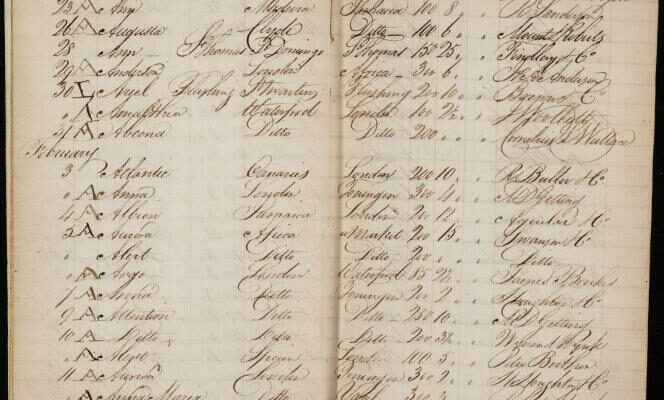The document is more yellowed on one side than the other but very well preserved. This is an old-fashioned, pre-printed administrative form with blank spaces to fill in. One day in August 1794, Fermin de Tastet entered the Royal Exchange building in the center of the City to negotiate one of these standard insurance contracts. Nothing could be more banal for this rich Spanish merchant based in England.
His colleague Sebastian de Lasa y Irala, who was then living in Havana, asked him to take care of covering the risks of Gipuzkoaa frigate docked in Liverpool, which must leave for the African coasts and transport ” goods “ to the Antilles. The only particularity: they are slaves.
Fermin de Tastet obviously worked well. “In the name of God, Amen”, as the contract begins, an agreement is reached. Around twenty insurers came together to cover the risks. The ship is insured for 3,500 pounds, or 450,000 euros today. “Slaves are valued at 45 pounds each”, specifies a handwritten note. Or around 5,000 euros today. The number of slaves transported, although uncertain, is estimated at around three hundred.
Proof that the insurance sector was already well developed, everything was planned, down to the most chilling details. In the event of the death of a slave following a rebellion, his value was insured, beyond a 5% deductible. If the death took place on one of the boats used to transport the men between the boat and the mainland, a place considered more risky, the excess increased to 10%. There ” war “THE “piracy” and the “baraterie” (crew misconduct) were covered.
On the other hand, a ” simple “ Natural death on the boat, particularly from illness, was excluded from the insurance policy, because it was too common. According to the estimate from the Transatlantic Slave Trade database, which details the transport of the 12.5 million people who were victims of transatlantic human trafficking, 12.2% of slaves died during the crossing. The massacre was of such magnitude that the risks were too high for insurers.
Insurance, a key element of slavery
In the history of slavery, the insurance contract signed by Fermin de Testet is one of the only complete, detailed ones found, containing the list of insurers and calculations of the “valuation”. “This document shows the horror and violence of slavery, but also the necessary sophistication that made it possible”believes Alexandre “Sasha” White.
You have 85% of this article left to read. The rest is reserved for subscribers.
